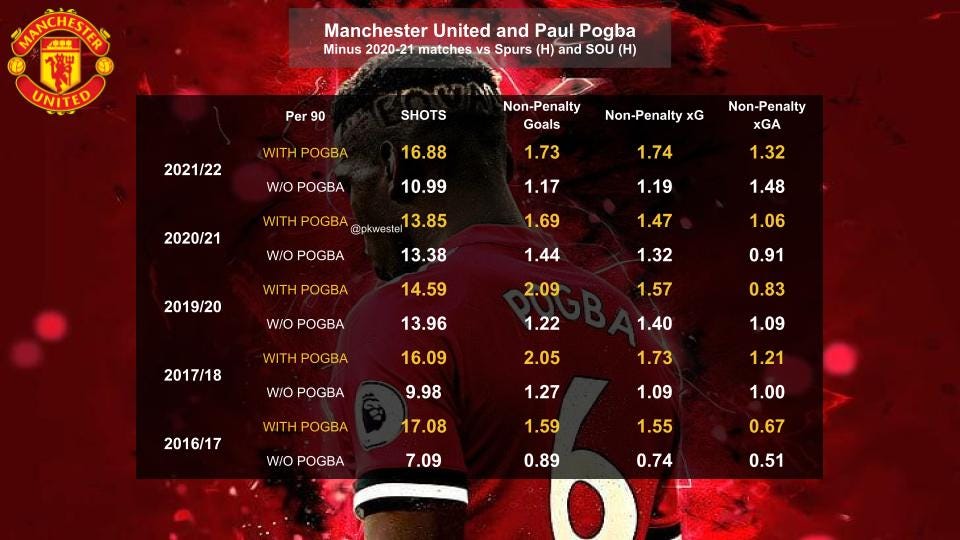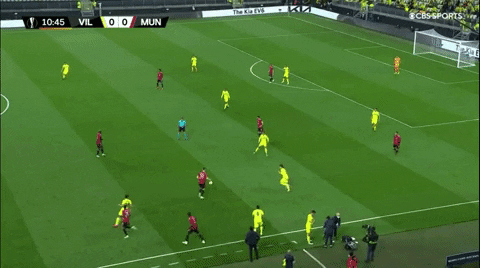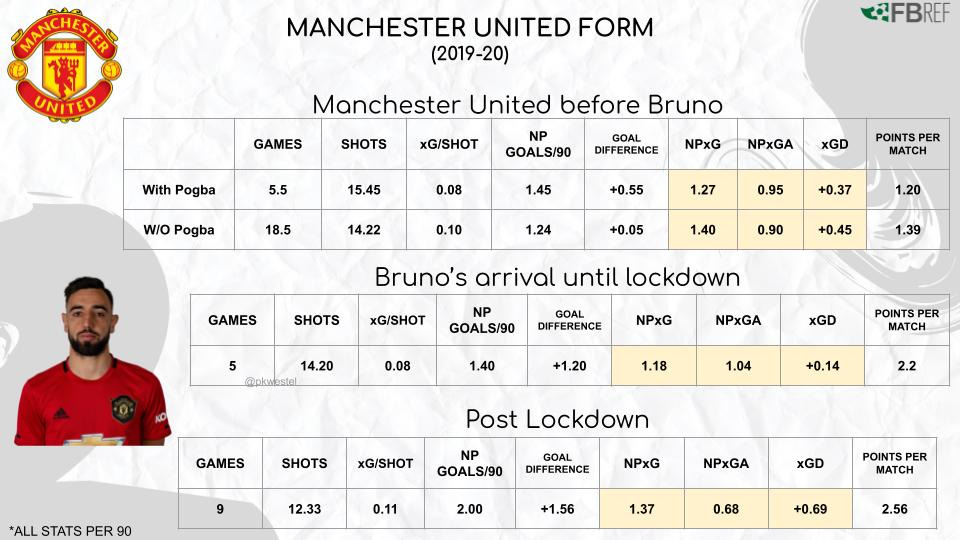Floor Raisers vs Ceiling Lifters
Some players lift the floor of their team to make them better while others are described as someone who raises the ceiling. Are we sure our thinking of who's who isn't backwards?
Two weeks ago was Paul Pogba’s 30th birthday and to mark the occasion The Athletic released a special podcast looking back at Pogba’s career discussing what made him a special player, made him a frustrating player, where he succeeded, where he failed, and why he’s so polarizing.
Even a Pogba fan will admit his time at Manchester United was frustrating at best. The pretty widely accepted viewpoint is that Pogba was a bit of a luxury player. Someone who elevated the ceiling of the squad but didn’t actually make them better. Then in January 2020 Bruno Fernandes joined the club and was essentially everything that Pogba was supposed to be1. Whereas Pogba lifted the ceiling of United, Bruno raised the floor - making them a better team.
I’ve gotta tell ya something.
To me, that’s all a crock of shit. When it comes to ceiling lifters vs floor raisers I think everyone’s got it completely backwards.
Now look, I’m fully aware that if everyone is on one side of the argument and I’m alone on the other side I’m probably the one who’s wrong but, hear me out…
At it’s most basic level, the floor is your foundation. It’s the ground level, you can’t go lower than that. When thinking about this in football terms the lowest you can go is going to be entirely be based on your defense.
If you don’t concede a single goal all season you can’t possibly lose a single game. You are guaranteed to finish the season with a minimum 38 points - likely just enough to avoid relegation. That’s your floor.
You can’t look at a team that doesn’t concede a single goal and say “they’re locked in to be champions” or “they’d finish no worse than top four” because, what if they don’t score any goals?
Their floor is 38 points. How high you can finish - or their ceiling - will be determined by how many goals they score.
Say this mythical team scores 20 goals in the season. Then their ceiling would be spreading those 20 goals out over 20 1-0 wins and 18 0-0 draws for a total of 78 points. Not enough to win a title - at least since the 90s - but almost certainly enough to make the Champions League.
But what if those 20 goals all came in just 11 games? That’d give you 11 wins and 27 draws. That’s just 60 points. Likely not enough for the Champions League. Your ceiling is based on how many goals you score.
Look at it from the other way. Let’s say a team scored 802 goals in a season - 2.11 goals per game. Would you say their floor is a top two finish? Well what if they concede two goals per game? You're not going to be winning any titles with a +0.11 GD per 90. You probably won't make the Champions League either.
There was one season where Manchester United conceded 33 goals and finished second in the table. The following season they conceded 43 goals. If a team concedes 10 more goals than the year before you would expect them to fall down in the table right?
You’ve probably guessed that this is in fact the Robin van Persie season of 2012-13. Van Persie came in and effectively instilled a “we’re gonna score one more than you” attitude into the team and they won the title. Van Persie didn’t raise the floor of this team. By conceding 10 more goals the floor had become lower, but Van Persie raised the ceiling for what you could accomplish with that floor. If you took away his goals where would they be? Well the following season United also conceded 43 goals, only this time Van Persie scored 14 fewer goals and United’s total goals count dropped by 22. They finished 7th.
The further back a player’s position is the more likely that player is going to be a floor raiser. Therefore the further forward a player is the more likely he’ll be a ceiling lifter.
A floor raiser is someone who makes you better when he’s in the team. He does things that allow his teammates to raise their levels. If he doesn’t have a good game individually you still have a good chance of getting your result. A ceiling lifter is someone who can perform despite their teammates (lack of) ability, but if he doesn’t have a good game, you’re probably not going to win. That makes central midfield the area of the pitch with the highest potential to raise your floor - specifically your deeper central midfielder. Those are the players with the responsibility of protecting the back four as well as getting the ball to the attacking players.
For years we saw United try to phase out Michael Carrick over the first few months of the season, only to be incredibly inconsistent. Then Carrick would come into the team and suddenly United would start winning. He raised the floor. Nemanja Matic was also a floor raising type. Year after year United conceded fewer goals when he played.
Casemiro has been the ultimate floor raiser. United concede 0.7 fewer open play goals per 90 when he’s on the pitch and their NPxGA drops by 0.85. It’s very hard to lose when he’s on the pitch - and this season United have only lost three times in the 293 matches he’s started (in all competitions). But Casemiro's ability to be goal threat - especially on set pieces - makes him one of the rare players to be both a floor raiser and ceiling lifter.
How does this have anything to do with Pogba? Those guys are all holding or defensive midfielders, which Pogba is not.
Paul Pogba spent the majority of his Manchester United career playing in a midfield pivot - a deeper position that’s more likely to be a floor raiser than ceiling lifter. Unlike the players listed above, Pogba isn’t going to raise your floor by making you better defensively4. To see where Pogba raised United's floor we have to look a bit further up the pitch and see how he impacted United's attack.
Take a look at United’s attacking numbers from five of Pogba’s six seasons at Old Trafford. The 2018-19 season is not included because Pogba only missed four games, making the sample sizes very uneven, and he spent a good chunk of the season playing further forward.
In all but one season United took more shots when Pogba was on the pitch than when he wasn’t. Their non-penalty xG also dropped when Pogba wasn’t playing and unsurprisingly so did their actual goal scoring. The one season where those drop-offs don’t happen also happens to be a season where Pogba played a match where United had 10 men for about an hour and missed a match where United went against 10 men for 89 minutes. If we take those two outliers out, the numbers that season look a bit different.
The difference in shots and xG is no accident - especially in the Mourinho days when the Portuguese built his team around Pogba. In each of his seasons in Manchester Pogba was always among the top four or five deep midfielders in the league when it came to progressive passes per 90, passes into the final third, and passes into the opponents box.
In other words, when Pogba was on the pitch, United’s attackers got the ball in dangerous positions more often. That raises the floor of your attack. If your attackers get 15 opportunities in a game to run at defenders they’re going to create more scoring chances than if they only get six of those opportunities.
When Pogba wasn’t on the pitch, there wasn’t anyone who could play those incisive passes. The attackers got the ball less often and in less dangerous positions - thus there was less opportunity to create something. The attacking floor was lower.
From a deep position Pogba could only play the passes to get his attackers into good spots. From there, you still had to rely on the attackers to actually create chances from their good opportunities.
Now look at Bruno Fernandes. As mentioned before, the popular sentiment is that Bruno came in and raised the floor of the team. But that’s not exactly what happened.
Whereas Pogba plays deeper, Bruno came in and played further forward as the number 10. His job is to directly create and score goals - but in order to do that, you have to get him the ball further up the pitch.
If you can’t get him the ball, he’s not going to be able to make a big impact. Therefore he’s not going to raise your floor, but if he does it all on his own, he can raise your ceiling. The underlying numbers tell the same story.
Take a look at the numbers from the 2019-20 season5 and see how United were playing before Bruno arrived and between when he showed up and Pogba returned.
As you can see, United’s underlying numbers don’t get any better once Bruno arrives. They’re taking the same amount of shots but their xG drops a bit. What does get better is their actual goal scoring. What gets much better is United’s point per match, how they turned those goals into results.
Bruno was operating with the same floor of attack as United had in the first half of the season when Pogba was injured. Yes five games is a very small sample size but look again at the numbers without Pogba from the 2020-21 season - they’re remarkably similar to this five game spell.
United were only going to get so many opportunities to create shots and goal scoring chances. Working within that framework Bruno essentially said “we’re just going to be more efficient.” Score more goals from the same number of chances. He’s lifting the ceiling.
Pogba did have a stint where he lifted the ceiling for United. During Solskjaer’s interim period in the 2019-20 season Pogba was played on the left of a 4-3-3 and played further forward. During that period he raised the ceiling of a club when attackers like Anthony Martial and Jesse Lingard weren’t scoring. For most of his time though, he was deployed deeper and was more of a floor raiser.
Attacking players are never going to raise the floor of your team. They’re always going to be ceiling lifters.
You can add Kylian Mbappe to your team but if you can’t get your attackers the ball in the final third your floor is still going to be extremely low. Mbappe may be able to drop deeper, pick up the ball, and do some magic all on his own to get some goals, but that’s not raising your floor. That’s lifting the ceiling of a team with a very limited attack. After all, he’s not going to be able to do that every single game.
Right now, Harry Kane is the ultimate example of a ceiling lifter. Tottenham are a painfully average side who are conceding 1.43 goals per game. If you’re conceding 1.43 goals per game it would be fair to say your floor is in the relegation zone.6 Your ceiling shouldn’t be much higher than mid-table.
Tottenham are a painfully average team, but they have Harry Kane who is really really good. Every so often Kane puts the team on his back and carries them to a win7. If Kane doesn't have a good game, Spurs have almost no chance of winning8. That's not raising their floor. That's lifting the ceiling of an average team that should be mid-table at best into probably finishing in the European spots. Maybe even the Champions League!
We’ve got this whole thing backwards. The foundation starts at the back! When assessing players we should think that Defenders and midfielders are going to be the floor raisers. A good attacker may help you win more games, but he’s not raising your floor, he’s lifting your ceiling.
Or I don’t know. Maybe you all are right and I’m the one that’s wrong here.
Mostly due to very bad expectations for Pogba that were more based on his price tag than his position
The average number of goals scored among all Premier League champions is 82
One of those because of an atrocious penalty
Over his six year spell United’s NPxGA was 0.1 lower when Pogba was on the pitch, but that’s such a small number that it’s far more likely due to the amount of times he played with Matic than having to do with him.
The 2019-20 season is a fantastic case study in to how important certain individual players are. Nemanja Matic, Pogba, and Luke Shaw all had a substantial impact on the numbers when they were in the team vs when they were missing.
Especially considering West Ham are currently in the relegation zone and they’re only conceding 1.31 goals per game
Kane has scored every goal in nearly 40% of Spurs’ wins this season
Kane has had nine games this season without a goal involvement. Spurs record in those games: 2 wins, 1 draw, 6 losses









I really liked this post. Excellent work here. I think you’ve brought me over to your thinking here.
This is beautiful